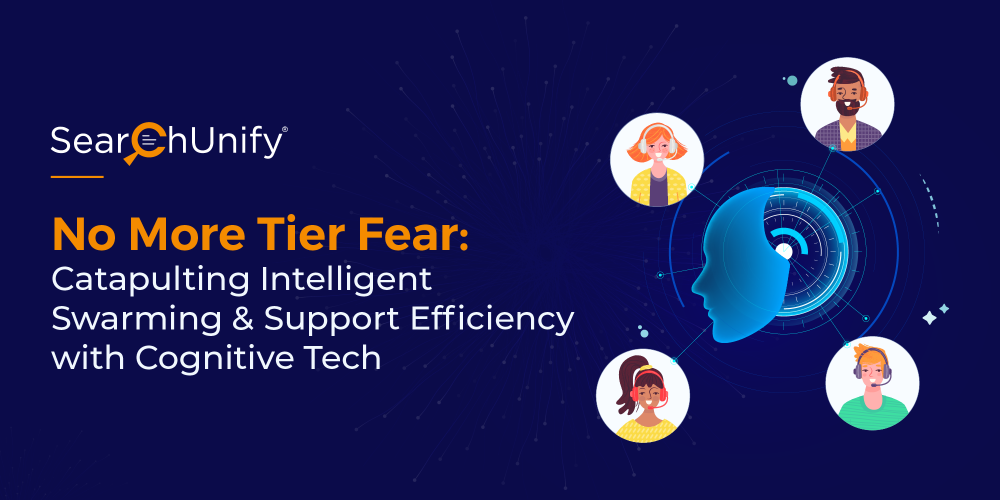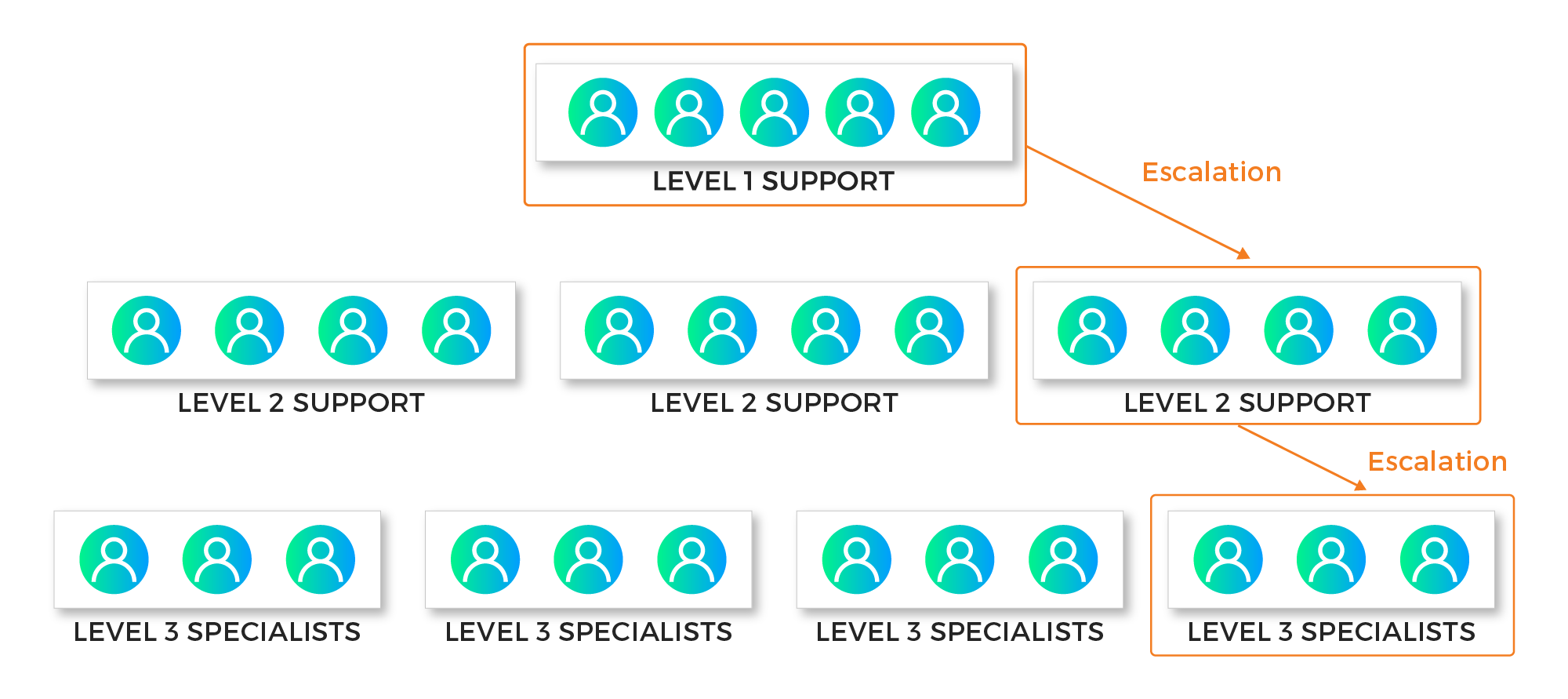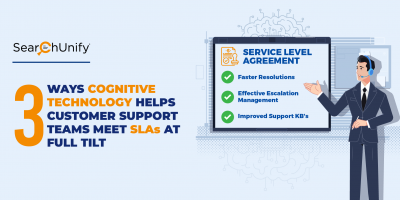
Imagine this.
You are the manager of an IT team of 40 agents, trying to heighten security on laptops and handhelds for about 2000 employees. Preferably, the support agents would want the employees to implement the changes by themselves following the step-by-step instructions sent over an email.
But kaboom! 350+ trouble tickets pile up in your helpdesk tool with one issue after the other. As a manager, what will be your approach for minimizing the volume of tickets?
You have two choices.
One, you choose an outmoded tiered customer support model – a linear escalation hierarchy where the troubled tickets of varying difficulty get escalated, passed on through rigid tiers and multiple queues. (as shown in the image below).

Or, you opt for intelligent swarming (IS) – a collaborative support model where one support agent will work on a ticket from start to finish, seeking the proper support from other agents as and when required. Thus, leveraging the collective expertise of a “swarm” of analysts.
For example, Rob is the go-to guy for all cybersecurity-related questions, while Ben works on the refunds. Let’s say Rob is assigned a refund-related ticket that he needs help with. Rather than forwarding tickets around until the right person is found, the ticket will be shared with Ben to provide the right contextual response to the customer instantly. After this, he can take over and finish the conversation.

As evident in the graph, the performance numbers for the collaborative support model are better in each case. There is an 11% increase in loyalty, a 13% increase in profit margin, far lower attrition, and 4.48 out of 5 for customer satisfaction in the collaborative support model (IS) as compared to the archaic tiered customer support model.
So, what will you choose to provide your customers? An inconsistent response or a consistent and quick response? The latter sounds better, right? Good choice!
“As per Live Chat Benchmark report, the average wait time for chat is 45 seconds.”
Intelligent swarming is a more efficient and streamlined approach to lower MTTR. Its deployment cultivates a framework for collaboration among support engineers, which breaks down the dreaded knowledge silos, thus improving support efficiency and CX.
To quote KCS Academy,
“The tiered support model of the past 35 years is giving way to a new structure and process: Intelligent Swarming (IS), a better way to align people with work.”
However, to continue to be an effective means for case resolution and unlock its full potential, intelligent swarming requires the right technology.
4 Ways How Cognitive Tech Fuels Intelligent Swarming for Support Efficiency
1. Gain Insights from Top SMEs
Sometimes, agents might need external help due to a lack of expertise on the said topic. This can be overwhelming and anxiety-inducing. Intelligent swarming helps your support agents connect to subject matter experts to fix the issue.
Support applications such as Agent Helper can make it happen. It acts as an inline assistant by suggesting top SMEs for incoming tickets to the support agents in real-time. This helps them connect with the SME to troubleshoot issues that they aren’t familiar with, thus reducing the overall time to resolution and also a lot of head-scratching.
2. Analyze Unstructured Data & Conversations
Have you ever wondered how much organizational information is stored in your collaboration platforms like chat, emails, social, and CRM? Enough to build a goldmine of insights.
There is plenty of unstructured data trapped in your systems that can provide incredible insights into customer behavior and pain points. You can leverage it to create more meaningful and contextual interactions. But it can be quite a task to break down communication silos and compile millions of invaluable conversations on email or chat to provide agents with contextual information.
The solution? Embed unified cognitive platform on top of your tech stack.
It can instantly index and integrate your team collaboration software with other enterprise platforms to ensure seamless access to the most relevant information from scattered data. Hence, it fuels the unification of disparate data silos to build a centralized knowledge repository that also taps into unstructured data.
This way, a unified cognitive platform helps your service reps offer a more connected experience.
3. Push Swarm Resolutions to Your Knowledge Base
Organizations adopted the dysfunctional practice of forgetting to create a knowledge base article, once a complex issue is resolved. By contrast, in a swarming model, the case resolution is captured in the knowledge base for future reference. Thank God for knowledge management systems!
But it can be tough to instill a culture of knowledge creation & sharing since the agents have a lot on their plate already.
That’s where apps like KCS Enabler help hit the nail on the head. It simplifies knowledge creation & discovery. With it, your agents can populate new knowledge base articles on the go and monitor, as well as quantify, their performance. In addition, it also facilitates knowledge-sharing, faster onboarding of new associates, and contribution to KB almost immediately.
4. Assign the Right Case to the Right Agent
In a time where customers expect immediate responses – the tiered support model promotes inconsistent response. A request may sit at a lower tier until appropriate information has been received from a higher tier rather than assigning the case to the best-fit agent.
“According to Salesforce, around 64% of consumers and 80% of business buyers said they expect companies to respond to and interact with them in real-time.”
Fortunately, apps that leverage cognitive technology propel automated ticket triaging, thereby catapulting intelligent swarming. Applications like Escalation Predictor can evaluate and direct support tickets to the best agent on the said topic. It can even extract customer sentiments through tickets and predict the chances of escalation.
The Bottom Line
Inconsistent response times can lure customers away. And anytime a customer cut ties, your organization has to deal with its implications. Adopting intelligent swarming can help you stand out among your competition and grow your business by effective triaging, faster skills development, improved employee morale, and increased customer satisfaction.
For Better Customer Support, Explore Next-Gen Cognitive Technology
Consumer trust isn’t disappearing – it’s shifting course. It’s time for you to change the course too. With cognitive technology, you can bridge the gap between what customers want and what support teams can realistically deliver. Tune in to our webinar to gain exclusive insight into the evolution of customer support from reactive to proactive models, and how a unified cognitive platform is powering synchronous real-time customer support.
















